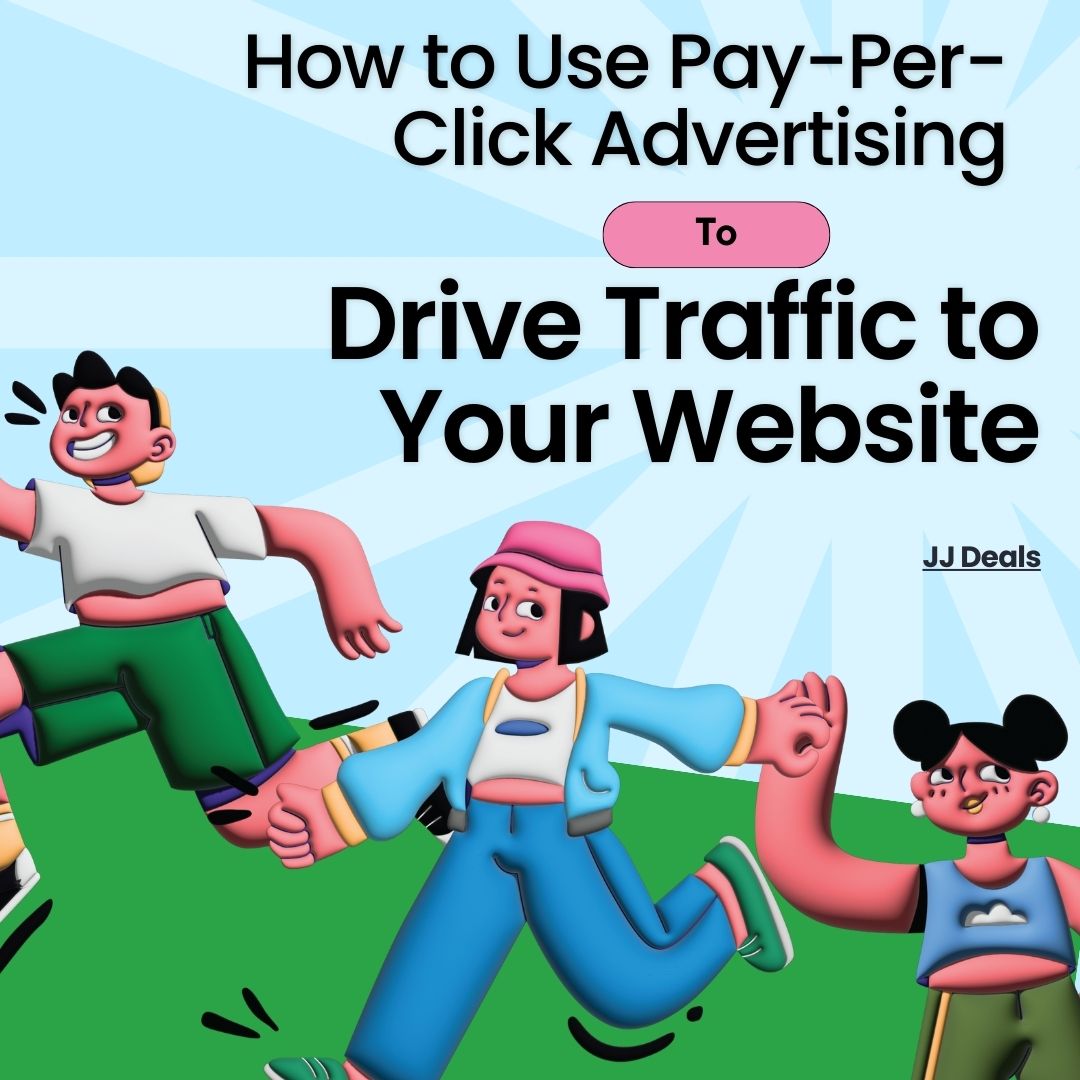
How to use Pay Per Click Advertising to Drive Traffic to your Website
How to Use Pay-Per-Click Advertising to Drive Traffic to Your Website
Pay-Per-Click Advertising to Drive Traffic is a type of online advertising where advertisers pay a fee each time someone clicks on their ad. This makes it a very effective way to drive traffic to your website, as you only pay when someone is actually interested in what you have to offer.
There are many different PPC advertising platforms available, such as Google AdWords, Bing Ads, and Facebook Ads. Each platform has its own strengths and weaknesses, so it’s important to choose the one that’s right for your business.
To create a successful PPC campaign, Pay-Per-Click Advertising to Drive Traffic, you need to:
Pay-Per-Click Advertising to Drive Traffic – Choose the right keywords

Choosing the right keywords is one of the most important aspects of creating Pay-Per-Click Advertising to Drive Traffic. The keywords you choose will determine who sees your ads, so it’s important to choose them carefully.
Here are some things to keep in mind when choosing keywords:
- Relevance: The keywords you choose should be relevant to your business and the products or services you offer. This will help you attract the right kind of traffic to your website.
- Search volume: The search volume is the number of times a keyword is searched for each month. You want to choose keywords that have a high search volume, but not too high. If the search volume is too high, your ads will be more expensive.
- Competition: The competition is the number of other businesses that are bidding on the same keywords. You want to choose keywords that have low competition, so your ads will be more likely to show up at the top of the search results.
- Keyword match types: There are different match types that you can choose for your keywords. The match type determines how closely your ad must match the search terms used by a user. For example, a broad match keyword will show your ad for a variety of search terms, while an exact match keyword will only show your ad for the exact keyword that you enter.
Once you’ve chosen your keywords, you can start creating your PPC campaign. You’ll need to set a budget, choose your bidding strategy, and create your ad copy.
By following these tips, you can choose the right keywords for your PPC campaign and create a successful campaign that will help you reach your target audience.
Here are some additional tips for choosing the right keywords:
- Use a keyword research tool to help you find relevant keywords with high search volume and low competition.
- Consider using long-tail keywords, which are more specific and less competitive than short-tail keywords.
- Use negative keywords to prevent your ads from showing up for irrelevant search terms.
- Track your results and make adjustments to your keyword strategy as needed.
By following these tips, you can choose the right keywords for your PPC campaign and create a successful campaign that will help you reach your target audience and achieve your business goals.
Pay-Per-Click Advertising to Drive Traffic – Set a budget

Setting a budget is another important aspect of creating a successful PPC campaign, Pay-Per-Click Advertising to Drive Traffic. PPC advertising can be expensive, so it’s important to set a budget that you’re comfortable with and that you can afford to spend.
Here are some things to keep in mind when setting your budget:
- Your goals: What are you hoping to achieve with your PPC campaign? Are you trying to generate leads, increase website traffic, or drive sales? Your goals will help you determine how much you need to spend.
- Your industry: Some industries are more competitive than others, and this will affect your budget. For example, if you’re in the retail industry, you’ll likely need to spend more on PPC than if you’re in the service industry.
- Your keywords: The more competitive your keywords, the more you’ll need to spend. This is because businesses are bidding against each other to show their ads at the top of the search results.
- Your bidding strategy: There are different bidding strategies that you can choose from. The bidding strategy you choose will affect your budget. For example, if you choose a bidding strategy that focuses on getting as many clicks as possible, you’ll likely need to spend more than if you choose a bidding strategy that focuses on getting more conversions.
Once you’ve considered all of these factors, you can start setting your budget. It’s a good idea to start with a small budget and then adjust it as needed. You can also set a daily budget, which will help you control your spending.
By following these tips, you can set a budget for your PPC campaign that will help you achieve your goals without overspending.
Here are some additional tips for setting a budget for your PPC campaign:
- Track your results: Once you’ve started your PPC campaign, track your results so you can see how your budget is being spent. This will help you determine if you need to adjust your budget.
- Be flexible: Your budget may need to change over time, depending on your goals, your industry, and the competitive landscape. Be prepared to adjust your budget as needed.
- Get help from a professional: If you’re not sure how to set a budget for your PPC campaign, you can get help from a professional PPC consultant. They can help you determine the right budget for your goals and your business.
By following these tips, you can set a budget for your PPC campaign that will help you achieve your goals and get a good return on your investment.
Pay-Per-Click Advertising to Drive Traffic – Write effective ad copy

Writing effective ad copy is another important aspect of creating a successful PPC campaign, Pay-Per-Click Advertising to Drive Traffic. Your ad copy is the text that appears in your ad, and it’s what will convince people to click on your ad and visit your website.
Here are some tips for writing effective ad copy:
- Be clear and concise: Your ad copy should be easy to understand and should get to the point quickly. People are more likely to click on an ad that they can understand quickly.
- Be persuasive: Your ad copy should convince people to click on your ad and visit your website. Use strong calls to action, such as “Click here” or “Learn more.”
- Be relevant to the keywords you’re targeting: Your ad copy should be relevant to the keywords that you’re targeting. This means using the same keywords in your ad copy as the keywords that people are searching for.
- Use keywords in your headline: The headline is the most important part of your ad copy, so make sure to use your target keywords in the headline. This will help your ad show up for more relevant searches.
- Keep it short: Your ad copy should be short and to the point. People are more likely to read and understand a short ad than a long one.
- Use strong visuals: Visuals can help to make your ad more eye-catching and persuasive. Use high-quality images or videos in your ad copy.
- Test and optimize: Once you’ve written your ad copy, test it and optimize it to see what works best. Try different headlines, ad copy, and keywords to see what gets the most clicks and conversions.
By following these tips, you can write effective ad copy that will help you create a successful PPC campaign.
Here are some additional tips for writing effective ad copy:
- Use a strong call to action: Tell people what you want them to do, such as “Click here” or “Learn more.”
- Use emotional appeals: People are more likely to be persuaded by ads that appeal to their emotions, such as fear, desire, or curiosity.
- Use humor: Humor can be a great way to get people’s attention and make them more likely to click on your ad.
- Be creative: Don’t be afraid to be creative with your ad copy. The more unique and interesting your ad is, the more likely it is to stand out from the competition.
By following these tips, you can write effective ad copy that will help you create a successful PPC campaign.
Track your results

Tracking your results is an essential part of creating a successful PPC campaign, Pay-Per-Click Advertising to Drive Traffic. It’s important to track the results of your PPC campaigns so that you can see what’s working and what’s not. This will help you optimize your campaigns for better results.
Here are some of the key metrics that you should track for your PPC campaigns:
- Click-through rate (CTR): CTR is the percentage of people who see your ad and click on it. A high CTR means that your ad is relevant and persuasive.
- Cost per click (CPC): CPC is the amount of money you pay each time someone clicks on your ad. A high CPC means that you’re bidding too much for your keywords.
- Conversion rate: Conversion rate is the percentage of people who click on your ad and take a desired action, such as making a purchase or signing up for your email list. A high conversion rate means that your ad is effective at driving conversions.
- Return on investment (ROI): ROI is the amount of money you make from your PPC campaigns compared to the amount of money you spend on them. A high ROI means that your PPC campaigns are profitable.
You can track your PPC results using a variety of tools, such as Google Ads, Microsoft Advertising, and Bing Ads. These tools will provide you with detailed reports on your campaigns, so you can see how they’re performing.
Once you’ve tracked your results, you can use the data to optimize your campaigns for better results. For example, if your CTR is low, you can try changing your ad copy or targeting different keywords. If your CPC is high, you can try lowering your bids. And if your conversion rate is low, you can try improving your landing page or offer.
By tracking your results and optimizing your campaigns, you can create a successful PPC campaign that will help you achieve your business goals.
Here are some additional tips for tracking the results of your PPC campaigns:
- Set goals: Before you start tracking your results, it’s important to set goals for your PPC campaigns. This will help you determine which metrics are most important to track.
- Track the right metrics: Not all metrics are created equal. Some metrics are more important than others, depending on your goals. For example, if you’re trying to generate leads, you’ll want to track your conversion rate.
- Track your results regularly: Don’t just track your results once and then forget about them. Track your results regularly so you can see how your campaigns are performing and make adjustments as needed.
- Use a variety of tools: There are a variety of tools available to help you track your PPC results. Use a combination of tools to get the most accurate data.
By following these tips, you can track the results of your PPC campaigns and optimize them for better results.
PPC advertising can be a very effective way to drive traffic to your website. However, it’s important to do your research and create a well-planned campaign in order to get the most out of your investment.
How To Make PPC advertising drive traffic to your website – Await Soon. Keep watching our site. Here is a sneak peek of the topic that give you some additional tips for using Pay-Per-Click Advertising to Drive Traffic to your website:
- Use negative keywords. Negative keywords are words or phrases that you don’t want your ads to show up for. For example, if you sell shoes, you might want to add the negative keyword “free” to your campaign so that your ads don’t show up for searches like “free shoes.”
- Use ad extensions. Ad extensions are additional pieces of information that can be added to your ads, such as your phone number, address, or website links. Ad extensions can help to make your ads more informative and attractive, which can lead to more clicks.
- Use remarketing. Remarketing is a way to show your ads to people who have already visited your website. This can be a very effective way to reach people who are already interested in what you have to offer.
PPC advertising can be a very effective way to drive traffic to your website. By following these tips, you can create successful PPC campaigns that will help you reach your target audience and grow your business.
The Best PPC Advertising Companies for Your Business
WhatsApp Screen Sharing: The Future Of Video Conferencing?






